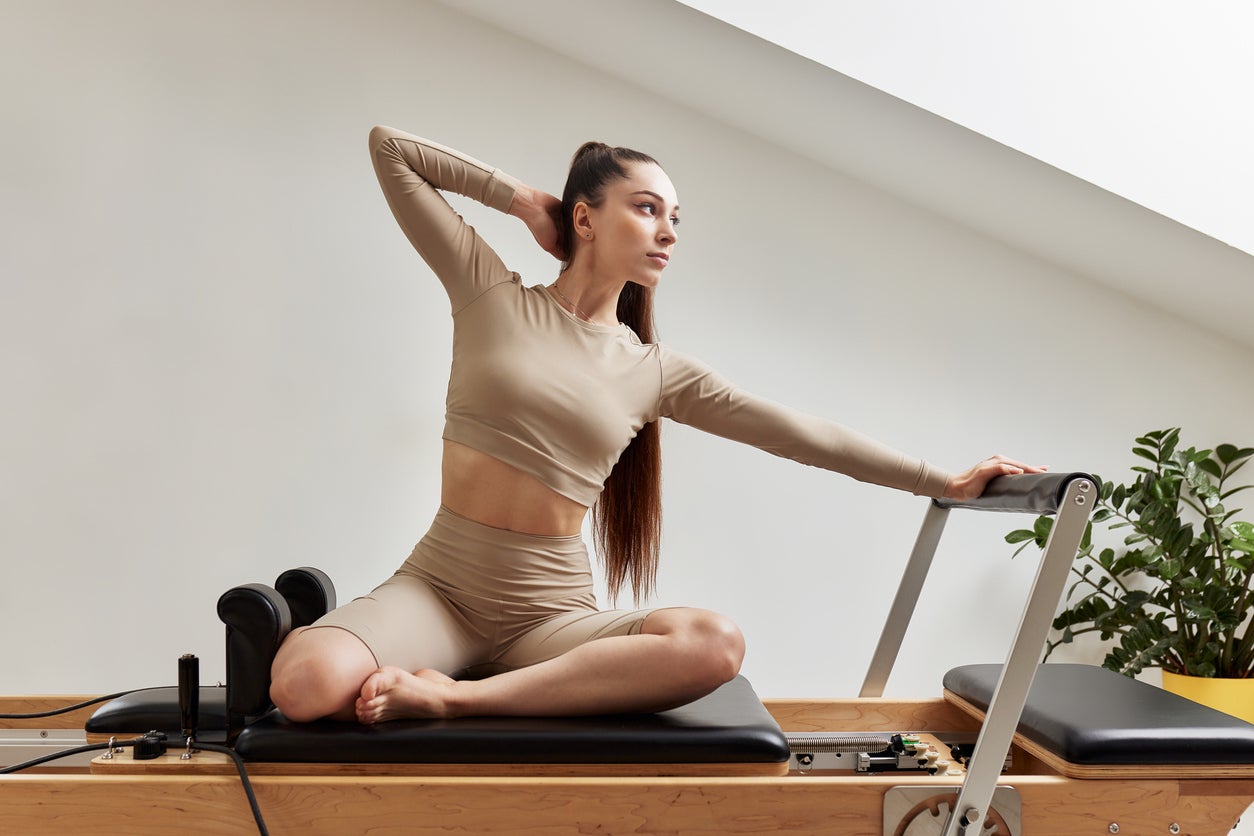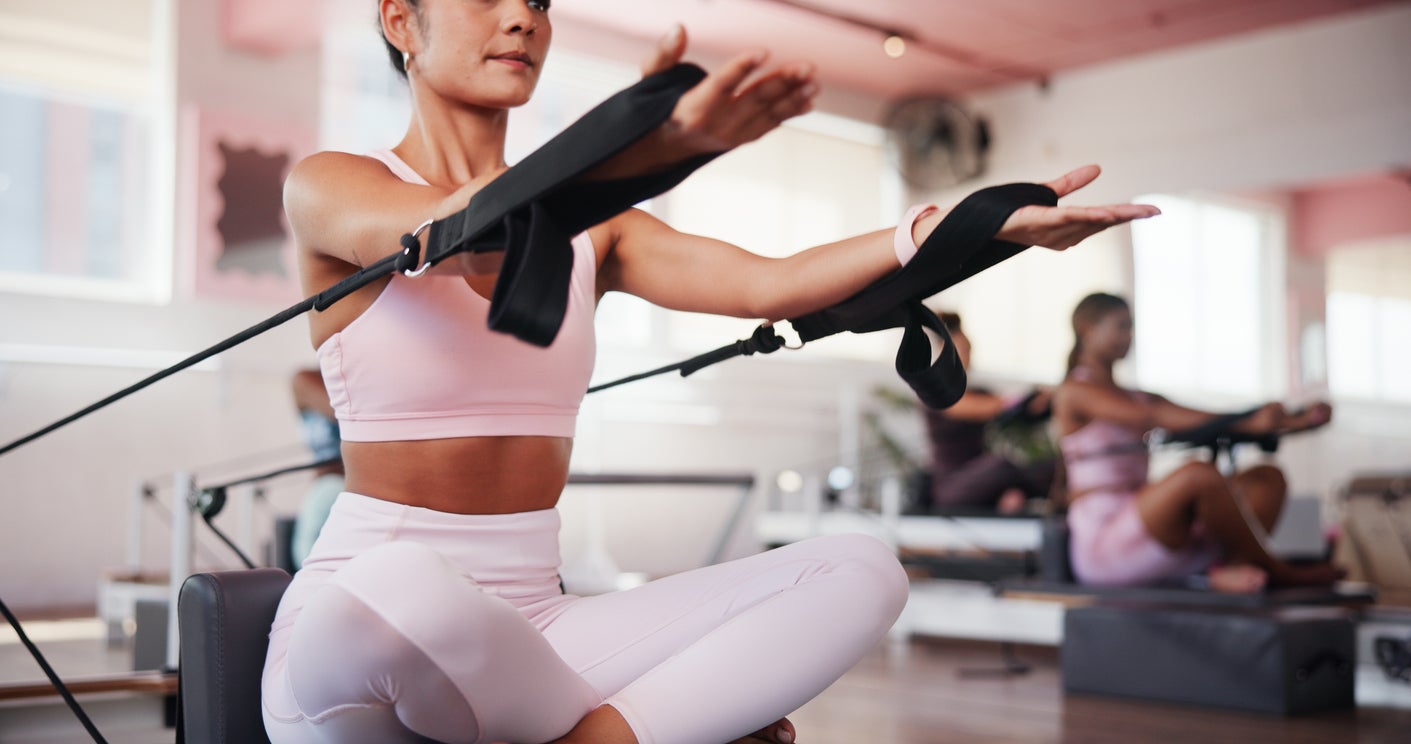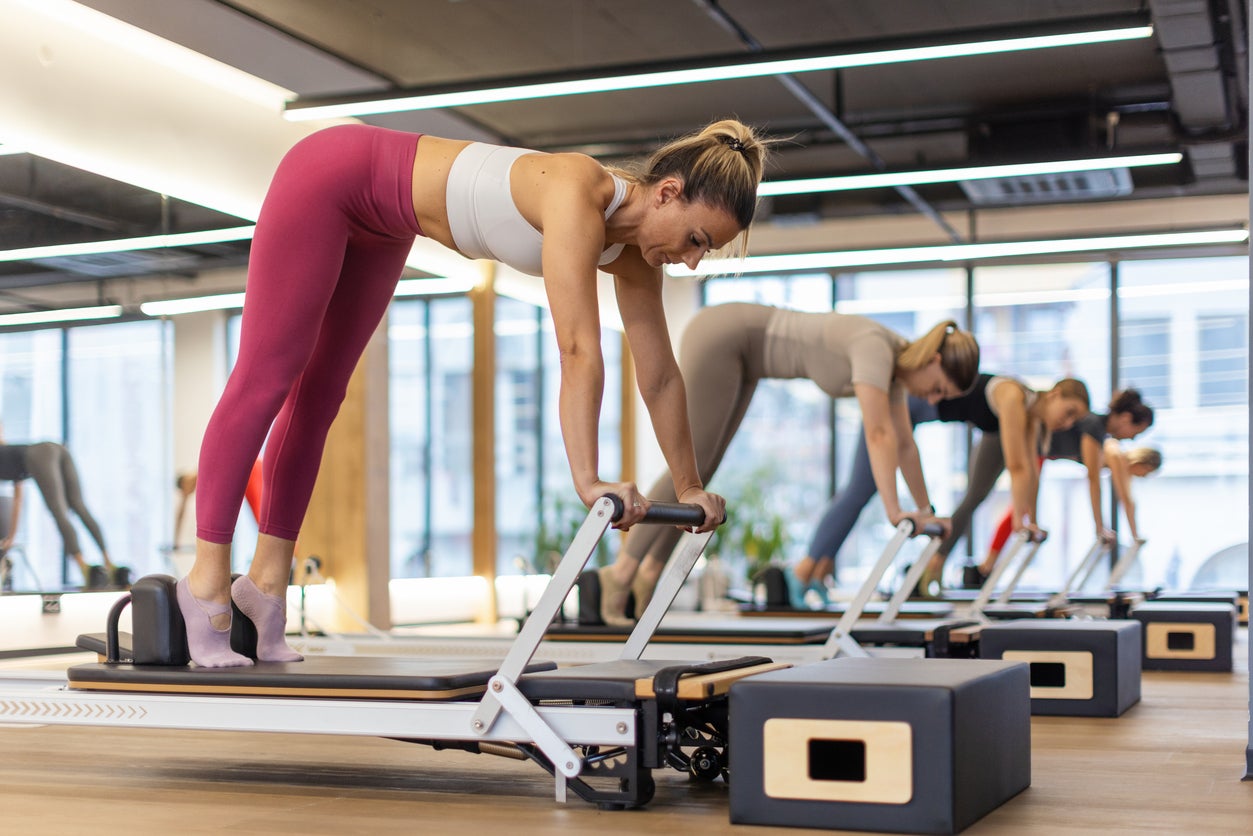It’s easy to spot a pilates princess from afar. I bet you can picture the woman I’m talking about. Her eternally youthful complexion is dusted with minimal yet glamorous makeup. She attends her thrice-weekly reformer pilates classes wearing matching pastel-coloured luxury athleisure sets. Her hair is neatly swept back into a glossy ponytail. Her carefully curated workout routine subtly dictates her schedule, as does posting pictures of her Instagrammable diet. Her occupation is unknown, but she unfailingly exudes affluence.
This is the version of young womanhood that leads the pack today. On social media, where aesthetics, self-discipline and control are all admired, she is everywhere; snapping herself while out for brunch, attending an overpriced fitness class or performing her multistep nighttime skincare routine.
On first glance, her togetherness might be the reason for the appeal. But if you put aside the Lululemon unitards, Rhode phone cases and shiny hairdos, it is not her lifestyle that’s most aspirational: it’s the slim, toned and straight “pilates body” that’s underneath. The latter term has – depressingly – become a newly celebrated physique category in recent months, where subtly ripped wellness influencers, once committed to Romanian deadlifting their way to the Kim Kardashian hourglass figure, are now promoting 28-day weight loss pilates programmes to achieve a more slimmed-down, minimalist physique. In one clip that constantly haunts my Instagram algorithm, an influencer claims to have lost several kilograms from just 28 days of reformer pilates using at-home equipment.
On TikTok, another influencer simply writes “Pilates body > Gym body” alongside a mirror selfie of her sculpted stomach. The hashtag #pilatesbody on TikTok is littered with dozens of “before and after” shots of those who have supposedly invested in these workout routines. If, on 31 December, we all reflected on body types that defined 2025, I’d wager that the “pilates body” would take top spot.
In this new beauty standard or subculture, everything is coded. “Pilates arms” (toned but not too muscly), “pilates abs” (a subtle but defined four-pack), and being a “pilates princess” (the complete embodiment of this beauty standard) are all actual accepted terms being used online in a normalised way. While the pilates princess has existed under different identities – for example, in the late 2010s, the explosion of barre workouts had a similar cultural impact – the “pilates body” is, to me, the most noticeable pivot from the cola-bottle shaped Kardashians-style body trend. It’s one that dominated popular psyche for a good decade, prompting the mass pursuit of booty-building workout plans (or seeking overseas Brazilian butt lift and fat transfer procedures instead). Those women are now searching for something slimmer and – as they would probably put it – refined. Another day, another unattainable standard of beauty.
What’s more interesting, though, is that the toxic nature of the body has gone widely unacknowledged. In the post-Body Positivity era, plenty of faddish trends receive backlash online, but the pilates body has arrived under the guise of wellness with little critique.
It all began, really, with a harmless interest in reformer pilates among young women, which led to a quite sudden demand. It has been big business: almost every UK city is now home to a reformer pilates studio, London is swarmed with them and the amount will only grow: Californian company Club Pilates has announced it will open up to 75 new branches across the UK in the coming years.
While regular pilates – a practice founded 100 years ago by Joseph Pilates – involves smooth, slow-paced exercises on a mat, reformer happens on a medieval-looking bed, complete with straps, a moving carriage and springs, for an added layer of resistance. Lower body exercises involve lying on your back, attaching the straps to your ankles and tracing infinity signs with your feet. As someone who has tried and tested plenty of reformer classes, I can attest to it helping improve my core strength, balance and general mind-body connection. But it is also an expensive hobby: in London, classes average £30, but memberships can be much higher (one Kensington hotspot, Karve, offers 100 classes per year for £2,450).
While it’s difficult to pinpoint when a genuine buzz surrounding reformer pilates turned into a newfound beauty ideal, we know the sheeny pages of Instagram and TikTok have played a part. Dr Kat Schneider, a research fellow studying changing body image trends at UWE’s Centre for Appearance Research, tells me how she’s witnessed a “noticeable shift away from the curvy hourglass aesthetic” popularised by celebrity figures in the mid-2010s, towards the “pilates body”. “Social media is a key driver behind this minimalist, polished, wellness-oriented aesthetic, which is dominating visual culture,” says Schneider. She says that the aesthetic – very much rooted in ideals of thinness – is tied up in other recent lifestyle movements, such as the clean girl aesthetic (which entails displaying an effortless and polished existence) or the quiet luxury movement (all about elegance and refined consumption). “It’s essentially where control, discipline and pristineness are prioritised,” says Schneider. “This ‘pilates body’ aligns with this cultural narrative of restraint, minimalism and wellness.”
Above all, no matter the trend, the cult of thinness is on the rise, despite the failed attempts of the 21st century’s body positivity movement. Trends repeat and change themselves all the time – and Schneider would argue that the pilates body has the biggest crossover with the 1980s aerobics aesthetic, popularised by Jane Fonda (albeit wearing Lycra leotards and legwarmers). “The beauty ideal has remained thin, so ‘thin with curves’ or ‘thin but toned’ or ‘thin but muscular’, or just ‘plain thin’,” says Schneider. “The thin part has always stayed there – but now that appearance has been rebranded as focusing on wellness and health.”

It also can’t be ignored how the pilates body has risen in tandem with Hollywood’s embrace of weight loss drugs like Ozempic. Schneider says there’s plenty of evidence to suggest that the existence of weight loss drugs is allowing people to undo the signs of the trends that came before, and physically adapt to changing beauty ideals surrounding thinness. “These drugs are making it much easier for most people to pursue a more slender physique, at least in the short term,” says Schneider. “We’re seeing the reversal of Brazilian butt lifts, fat removal procedures and an increase in starvation diets. It’s this rebranding that’s happening, one that suggests thinness equals wellness, which is obviously not the case.”
It’s worth noting that pilates was never designed for weight loss, nor do fitness trainers or doctors prescribe pilates-only workout plans for those desiring drastic results. Laura Thornton, a pilates practitioner of 10 years and owner of the Form and Flow studios in Warwickshire and Stratford Upon Avon, tells me that 28-day pilates challenges, those that you’ve likely seen swarming your Instagram feed, completely miss the point of the practice. “In our training, we’re taught that this exercise is about moving your body this way for aligning this way, for working on mobility or stability,” says Thornton. “We’re not really trained to change your body in terms of size and aesthetically in real life. In the studio, we work with a lot of people who have kind of common injuries like bulging discs, knee replacements, knee surgeries, rehab, things like that.”
Thornton has noticed that these weight loss pilates regimens being advertised online often contain false advertising and misinformation. “A lot of the people promoting these workout plans already have the desired body for what they’re selling. The effects of pilates are never linear person to person.” Thornton sees these challenges as “quick fixes” when pilates is about longevity. “The history of pilates is about rehabilitation, about helping you feel better and create lifelong sustainable changes.”
Joseph Pilates, the German personal trainer, gymnast and boxer behind the practice, was a lean, stocky man who would probably scoff at the popularity of weight loss drugs today. He developed his method, called “contrology”, during the First World War while being held as a prisoner of war at Knockaloe, an internment camp on the Isle of Man. Pilates developed a range of makeshift contraptions to stretch and strengthen the body with the limited space and resources he had, such as a “spine corrector” (a curved apparatus designed to support and challenge the spine) and the early beginnings of the reformer machine, created by attaching springs to hospital beds, so that patients could start toning their muscles even while they were still bedbound.
Thornton says the boom in pilates has been brilliant for the industry, particularly since it has introduced a much younger audience to the practice. Though she does worry that its new, moneyed image will alienate other newcomers. Indeed, it’s true that the beds provided by some studios don’t accommodate people with larger bodies, while popular luxury athleisure brands don’t stock above a size 14. “If you go into a long-standing studio such as mine, it is a mix of all ages, sizes, abilities, races, genders, everything. It seems that social media has projected this idea of wealth and affluence, and it being exclusive to very thin, able-bodied, slim people. And that’s not a real representation of the real classes.” So it’s not all Lululemon and Stanley cups? “I definitely turn up in a baggy T-shirt,” she laughs.

While practitioners like Thornton provide inclusive and accessible classes, there’s no denying that the idolised “pilates body” has become linked with elitism. Trends surrounding women’s bodies have always been connected with class and communicating affluence. Schneider tells me that centuries ago, wealthier women were proud of having larger bodies, because it signified they were able to afford food and didn’t have to engage in laborious work. It’s a different story today. “In the last 1,500 years or so, thin has always seemed to be in, because it’s associated with things like control and money.” The pressure to be thin affects everyone, but women face an acute level of pressure. “It’s become about shrinking yourself, and spending time and effort on your appearance.”
Exclusiveness, both financially and aesthetically speaking, is nothing new in exercise. There’s been barre, CrossFit, booty band workout routines and hot yoga that have come before. But never before has wellness been put behind such an impenetrable paywall. In her 2019 memoir Trick Mirror: Reflections on Self-Delusion, Jia Tolentino summed up the barre phenomenon excellently. “I felt acutely conscious of being in the company of other women who had, like me, thrown their lot in with this pursuit of frictionlessness. We all made, or were trying to make, enough money to afford this expensive class, which would give us the strength and discipline that would ensure that we would be able to afford this expensive class again. We were embracing, with some facsimile of pleasure, our era of performance and endless work.”

Our pilates princess, then, is a prototype of modern culture’s obsession with self-optimisation. Most evident in the post-pandemic content era, where people brag about their 5am-to-9am side hustle before their 9am-to-5pm job, their exhausting wellness schedules and meal prep routines, regimenting yourself to the point of tedium has become the ultimate signifier of “I made it”. Whether chasing that unattainable image of perfection is making us plain boring is another thing entirely. In an article for Dazed titled “Is fitness culture making us sad and boring?” Laura Pitcher wrote that it’s become a “strange flex to skip the social function for the sake of your workout” and highlighted the actual cost of not socialising while people chase a non-existent self-improvement finish line.
As we sprint after the latest body standard, we might lose sight of what is actually good for us. Schneider says that the wellness industry’s relationship with self-improvement has led to people exercising purely for aesthetics, rather than engaging in physical activity for joy-seeking, general mental wellbeing or as an opportunity to socialise with friends.
“You can’t sell true wellness – regular movement practice, a relatively balanced diet, having fun and a good sleep,” says Schneider. “Now, it’s only the extreme version of wellness that sells, like detox diets or supplements or regimented programmes.” If true wellness is unsellable, then it’s worth asking, what are we buying in the first place?



